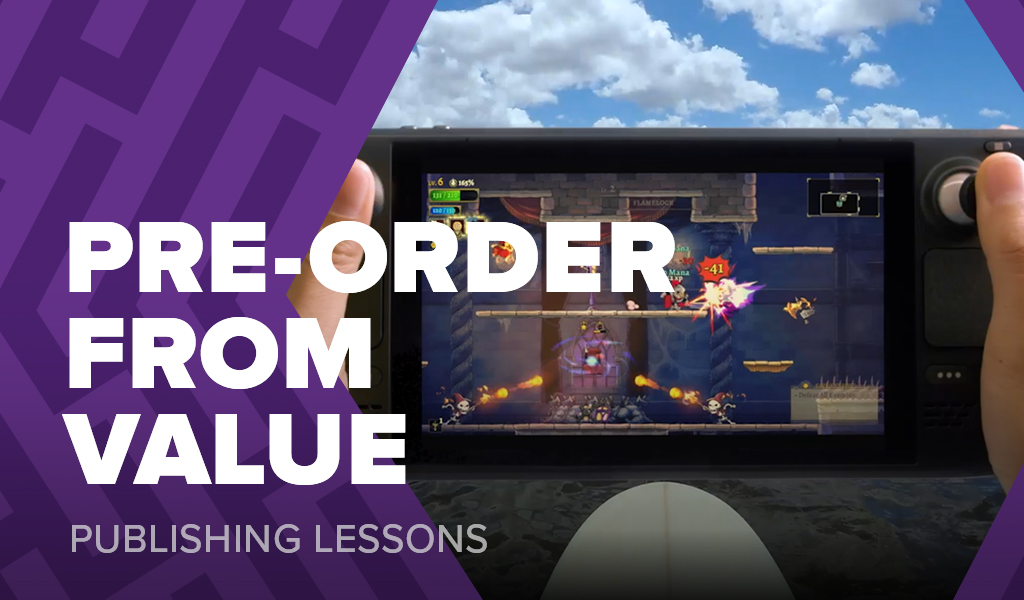The Valve approach to pre-orders

Last week Stonemaier Games released their brand-new Nesting Box for Wingspan, a large luxury organiser and storage solution similar to the 2-minute box for The Isle of Cats.
The box proved to be far more popular than expected and sold out in the US within approximately 6.5 hours and continued to sell out in other regions in the hours to follow. This is both a fantastic thing, as the product sold so quickly, but also frustrating for both Stonemaier Games and their customers, given how long it can take to print further copies.
I remember when The Isle of cats released in retail back in 2020 it was nearly impossible to keep in stock. The first 4 prints, which each were much larger than the previous prints, never lasted more than a week. In fact, despite 4 prints arriving with my US distributor in the first 12-months, the game was in stock for less than 4-weeks of the first year.
Finding a solution
Crowdfunding is one option for measuring demand early and getting numbers in place prior to starting a first print for a game. It isn’t perfect as I showed with my own struggle to get the retail numbers right for The Isle of Cats, but it certainly gave me a starting place.
But what if you don’t want to run a Kickstarter? Afterall, not every game is suited for crowdfunding and not every creator wants to use it.
Pre-order
You could setup a pre-order system and allow people to purchase the game before you start the first print run. However, this comes with all the problems that crowdfunding has.
- You’re having to share all the details about the game early so that your customers can make an informed decision.
- You need to get review copies out to people up to a year before you’re looking to release the game.
- You’re asking people to wait a long period of time from paying for the game to receiving it.
In reality, a pre-order is just a localised crowdfunding project without a funding goal that is hosted on a different platform without the benefits crowdfunding brings.
Launch signup
To avoid the 3 issues listed above with pre-orders, we can simply release a small amount of information about a product and ask people who are interested to signup for an announcement email.
For many people a name and short description is enough to know whether they might be interested. Let’s take the following 4 examples:
- This is a cooperative game for 2-players
- This is a party game for 5-10 players
- This is a worker placement game for 1-4 players
- This is a tile laying game for 2 – 6 players
After reading just a few words you’ve likely already made some decisions about which might be for you, and with a few extra sentences that decision becomes even easier.
The problem here is commitment is easy and typically these types of signups have a very low conversion rate. On a Kickstarter, approximately 20%-30% of project followers will actually back the project and with newsletters it can be significantly less.
You run the risk of having to make a guess on the numbers and it can go wrong.
The middle ground
Recently I wanted to purchase the highly anticipated Steam Deck from Valve, a handheld console priced at $300 – $700. I expect Valve knew it would be popular but had no way of knowing exactly how popular, and just like with board games, it is a physical product that takes months to produce and ship.
The last number I saw indicated they had shipped over 1 million units in the first 9 months.
They used a hybrid approach of pre-order and launch signup where they asked people to commit to a purchase and took a $5 payment. This put you into a shipping wave which was clearly shown on the website.
The first X people were told they would receive their Steam Deck in February, and then as more people joined the month changed to March, April and so on. I enjoyed the fact that at any point I could commit to buying one and seeing when I would get it, but also that I could see the month increasing as more people committed.
When your wave was ready to ship, you received an email asking you to make the final payment for your order and giving you 5 days to do so. If you failed to complete the order, you got a refund and the next person in the queue got their chance.
I think this is an interesting approach as by paying $5 you are showing a higher level of commitment than filling in a form, but not having to commit large sums of money to something you won’t get for a long period of time.
I wonder if this approach or something like it could be used for a board game. Perhaps where 12-months prior to release you can reveal a short summary and let people choose to commit a low sum of money (you wouldn’t need to reveal the MSRP if it isn’t set yet), or, they can choose to wait for more details and commit at a later date, but perhaps receive it a little later.
I worry that it does still play into FOMO (the fear of missing out) more than I would like, but perhaps that is unavoidable with a physical product that must be printed in fixed quantities months before release?
Frank West
Frank West is a gamer and designer based in Bristol, UK. He published his first board game, The City of Kings, in 2018 and now works on other games and organising events in the local area. His goal? To design and publish games focusing on immersive themes, fun mechanics and beautiful components. If you have any questions or would just like a chat, feel free to get in touch at any time!


7 comments
Jamey Stegmaier
10th November 2022 at 4:57 pm
Thanks for posting about this, Frank. We’ve discussed that approach a bit, and I’m a fan of this in particular: “I think this is an interesting approach as by paying $5 you are showing a higher level of commitment than filling in a form, but not having to commit large sums of money to something you won’t get for a long period of time.”
The problem (and the reason we’re not currently trying this approach) is that we’re not aware of a way to make it work as an automated process in Shopify (this part: “When your wave was ready to ship, you received an email asking you to make the final payment for your order and giving you 5 days to do so.”). Perhaps there’s a Shopify app/plugin for it that we’re not aware of.
Frank West
10th November 2022 at 5:17 pm
Hi Jamey, thanks for the comment!
Part of the inspiration for this article was a Shopify app I came across last night called “Advanced PreOrder(Partial Pay)” which allows people to partially pay for pre-orders. I have not investigated it any further yet and do not know how it manages the second payment but would presume it must handle it in some way.
I’ve allocated a large part of December and January to launching a new Shopify store and will be researching this along with other options during that time – I will let you know if I find anything!
Jamey Stegmaier
11th November 2022 at 2:15 am
Thanks Frank! I’ll ask our web dev to look into that option.
Alberto
10th November 2022 at 8:56 pm
What about a system like GMT’s P500? It’s kind of a cyclic ongoing crowdfunding campaign, and they do it for reprints, when the customers already have information on the game.
Frank West
10th November 2022 at 9:14 pm
I think that’s a great system for reprints and I really like the fact they use it to gauge demand, for a new game I’m not so sure.
It certainly avoids having to charge someone far in advance, but it still leaves the issue of providing people with enough information.
If someone is giving me the ability to charge them the full price of the game (even if I don’t take the money until much later), then they need to have the information ahead of time to make the buying decision. Otherwise they are effectively buying the game blindly which I wouldn’t be keen on.
Chris S.
11th November 2022 at 2:57 am
Thanks for the great post, Frank. Jamey’s blog entry brought the Steam Deck to mind for me as well. While the Deck release was a bit turbulent due to the manufacturing delays and the QC issues of the first waves, I agree there could be some promise to this model. A few thoughts:
Preorder Data
I think a tech analyst mentioned that Valve was operating on extremely thin margins with the $400 USD Decks and would thus be making the bulk of their profit off the premium Decks. Valve also initially predicted that the $400 model would be the most popular, but the preorders helped reveal well in advance that the premium models were in high demand as well. While this caused delays in manufacturing, it no doubt would have been much worse for both Valve and the customers if they had a limited stock of higher-end models with a traditional product release.
FOMO and Temporal Cost
I think that the reservation ended up costing me more than just the MSRP of the Deck because with the fluctuating dates, I felt I needed to check my inbox and spam folder a lot during my release Quarter. While this was by no means a heavy burden, it was nevertheless another to-do item that weighed on me, especially given the FOMO on the window and getting pushed back to the end of the queue.
Based on my observations of the Steam Deck subreddit, that fear seemed quite widespread. People organized a system to try to forecast when their preorder confirmation email would be sent. Also, at least in my batch, the payment confirmation window was only 3 days, so that added to the concern.
Possible ways to alleviate this:
-A “test” email, so that customers would trust that the real preorder email wouldn’t get snatched by the spam folder.
-A monthly or quarterly email for preorder customers, like Kickstarter campaign updates, to give a brief status update on the process.
-A larger window for confirming the preorder. Not sure if two weeks would be feasible, but a more forgiving window would help avoid situations where somebody might be camping or otherwise out of town for the weekend. Especially since we’ve had to contend with COVID, it’s probably not unrealistic for folks to be away from their inboxes for days while sick.
A Middle-er Ground?
I wonder if there would be any way to offer both the paid-in-full, year-in-advance preorder *and* the $5 down payment model? When I put my $5 down on the Steam Deck, I was already certain that I would be purchasing the product, as it met a specific need and use case for me. It would have been nice to be able to just pay for the Deck and then enjoy the peace of mind that I would receive it during my launch Quarter.
When making my purchase, the finer details of the Deck really didn’t matter to me. Only that it was a handheld, PS4-like gaming PC that would be able to run a good chunk of the Steam Library. I thus wonder if that might eliminate some of the challenges you mentioned with the preorder?
-Early details: You could use the “launch signup” description for the preorder, including both basic genre info and theme. So, for Race to the Raft something like “a cooperative, tile-laying game for 1-4 players set on the Isle of Cats” and for the Nesting Box, “Wingspan big box / organizer, bundled with the next expansion.” This model would work especially well with expansions since people have already bought into the core game.
-Review copies: I think fans of a designer/publisher whose reputation they trust wouldn’t necessarily need the opinion of reviewers to inform their purchase. Speaking personally, I mostly watch reviews of trusted designers’ games because I’m excited to learn more about the games, not because I’m trying to assess their quality.
-Long wait: To be honest, the wait really is half the fun. If I didn’t trust the publisher, sure, I could be concerned that the game wouldn’t be fulfilled or such. However, with City of Games and Stonemaier, it would be something to look forward to…like looking forward to next Christmas from January.
Frank West
11th November 2022 at 1:03 pm
Hey Chris,
These are some great thoughts and I can understand the burden of having to keep checking your emails in fear of missing out. I think a slightly longer window (perhaps a week) along with your suggestion of regular update emails would help with this a lot.
I expect if I was to follow this method, I would try to:
– Notify people 1 month in advance when I start releasing the full information.
– Tell people on the upcoming wave (although hopefully most would be on wave 1!) when the page will be live a couple of weeks in advance, so they can be sure to check their emails that week.
– Email everyone at the start of the week with their access.
I also agree a certain amount of people who follow a brand are likely to purchase blindly, but I still like to offer the right experience and not make people who’ve just discovered me feel like they are missing out or being pressured to make a decision without enough information.